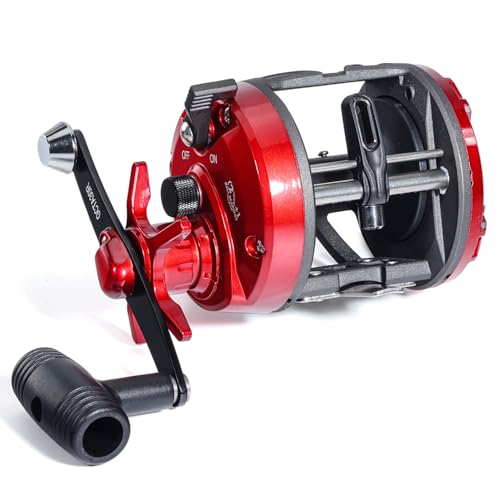To put a bobber on a fishing pole, slide the bobber onto the line above the hook. Begin by attaching the hook to the fishing line, and then slide the bobber onto the line, making sure it is at the desired depth.
When it comes to fishing with a bobber, learning how to properly attach it to your fishing pole is essential. A bobber, also known as a float, is a useful tool that helps anglers detect when a fish is biting.
By using a bobber, you can easily adjust the depth at which your bait is suspended in the water, increasing your chances of a successful catch. We will provide step-by-step instructions on how to put a bobber on a fishing pole, ensuring that you are ready to tackle your next fishing adventure with confidence.

Credit: fishing.scoutlife.org
Understanding The Importance Of A Bobber
When it comes to fishing, using a bobber is a simple yet effective technique that can significantly improve your fishing experience. Wondering why you should use a bobber? Let’s dive into the advantages and how it can enhance your fishing skills.
Why Use A Bobber When Fishing?
Using a bobber serves several purposes when you’re out on the water, trying to catch fish. Here are a few reasons why you should consider using a bobber:
- Visual indicator: A bobber acts as a visual indicator that tells you when a fish is biting on your bait. It suspends your bait at a specific depth, and when the fish takes the bait, the bobber moves, alerting you to a potential catch.
- Depth control: One of the key advantages of using a bobber is that it allows you to control the depth at which your bait is presented to the fish. By adjusting the position of the bobber on your fishing line, you can precisely target different depths, increasing your chances of snagging a fish.
- Tangle prevention: Another benefit of using a bobber is that it helps prevent your fishing line from tangling. When you cast your line, the bobber acts as a weight that keeps the line taut. This reduces the chances of your line getting entangled with itself or any surrounding obstacles, making your fishing experience smoother and more enjoyable.
Advantages Of Using A Bobber
Now that you understand why using a bobber can be beneficial, let’s explore some specific advantages it offers to anglers:
- Improved strike detection: With a bobber in place, you can easily spot when a fish strikes your bait. As soon as the bobber dips or moves, you’ll know it’s time to set the hook and reel in your catch.
- Enhanced casting accuracy: A bobber provides a target to aim for, allowing for more precise casting. By aiming at the desired location, you increase your chances of placing your bait in the right spot, where the fish are more likely to be.
- Versatile fishing conditions: Whether you’re fishing in still water like lakes or ponds, or in flowing rivers, a bobber can adapt to various fishing conditions. It remains buoyant even in moving water, enabling you to effectively fish in different environments.
How A Bobber Enhances Fishing Experience
In addition to the specific advantages mentioned above, using a bobber can enhance your overall fishing experience in the following ways:
- Simplified setup: Attaching a bobber to your fishing line is a quick and straightforward process. It requires minimal equipment and can be done in seconds, allowing you to spend more time enjoying the act of fishing.
- Engaging for beginners: For novice anglers, using a bobber provides an interactive and engaging experience. Waiting for the bobber to move or dip creates anticipation, making the fishing trip more exciting and enjoyable, especially for newcomers to the sport.
- Opportunity for experimentation: A bobber opens up a world of experimentation and customization. You can adjust the position of the bobber, change the bait, or try different depths to find the most effective fishing technique for the conditions you’re in.
Using a bobber adds an element of control, convenience, and excitement to your fishing outings. It allows you to optimize your bait presentation, detect strikes more easily, and keep your line tangle-free. Give it a try, and you’ll soon discover the benefits it brings to your fishing game.
Choosing The Right Bobber For Your Fishing Pole
When it comes to fishing, using a bobber on your fishing pole can greatly enhance your angling experience. A bobber, also known as a float, is a simple and effective tool that alerts you to fish bites and helps you control the depth of your bait.
But with so many options available, how do you choose the right bobber for your fishing pole? Let’s explore different types and sizes of bobbers and the factors to consider when selecting one.
Different Types And Sizes Of Bobbers:
- Fixed bobbers: These bobbers are attached permanently to your fishing line and cannot be adjusted. They are simple to use and great for beginners. Fixed bobbers are typically round or oval-shaped and come in various sizes.
- Slip bobbers: Unlike fixed bobbers, slip bobbers allow your line to pass through them freely. This allows you to adjust the depth of your bait easily. Slip bobbers are suitable for more advanced anglers as they require some technique to use effectively.
- Pencil bobbers: Pencil bobbers are long and cylindrical in shape, resembling a pencil. They have a narrow profile, making them more sensitive to fish bites. These bobbers are excellent for casting over long distances.
- Spring bobbers: Spring bobbers are designed specifically for ice fishing. They attach to the tip of your fishing rod and provide excellent sensitivity to detect the delicate bites of fish in icy waters.
- Sizes: Bobbers come in various sizes to accommodate different fishing conditions and target species. Smaller bobbers are suitable for fishing in calm waters with smaller fish, while larger bobbers are needed for rougher waters or when targeting larger fish.
Factors To Consider When Selecting A Bobber:
- Fishing environment: Consider where you will be fishing. If you’re fishing in still waters, a fixed bobber may be suitable. Slip bobbers work well in flowing waters or areas with varying depths.
- Target species: Different fish species have different biting behaviors. For example, panfish may gently nibble on your bait, while bass may bite more aggressively. Choose a bobber that is sensitive enough to detect the bites of your target species.
- Depth control: If you want to fish at a specific depth, look for a bobber that allows easy adjustment of your bait’s depth. Slip bobbers are perfect for this purpose.
- Visibility: Make sure your bobber is highly visible in the water, especially in low light conditions or when fishing from a distance. Brightly colored bobbers with reflective surfaces can greatly enhance visibility.
- Durability: Select a bobber made from durable materials that can withstand the rigors of fishing. Bobbers made from plastic or balsa wood are popular choices.
Matching The Bobber To Your Fishing Technique:
- Casting and retrieving: If you are casting and retrieving your bait, a slip bobber or pencil bobber is a good choice. They can be easily cast over long distances and retrieved smoothly.
- Still fishing: For stationary fishing techniques, such as fishing from the shore or using a fishing pole holder, fixed bobbers or slip bobbers can be used. Adjust the depth according to your targeted fish’s preferences.
- Ice fishing: When ice fishing, spring bobbers are highly recommended. They provide excellent sensitivity to detect the gentle bites of fish below the ice.
Now that you know the different types and sizes of bobbers and the factors to consider, you can confidently choose the right bobber for your fishing pole. Remember to match the bobber to your fishing technique and target species, and enjoy the added excitement and control a bobber can bring to your fishing adventure.
Step-By-Step Guide To Attaching A Bobber To Your Fishing Pole
When it comes to fishing, having a bobber on your line can greatly enhance your chances of success. A bobber serves as a visual indicator, alerting you to any fish nibbling at your bait. It also helps you to keep your bait at the desired depth in the water.
If you’re not sure how to attach a bobber to your fishing pole, don’t worry! Follow this step-by-step guide and you’ll be ready to go in no time.
Inspecting Your Fishing Line And Bobber
Before you start attaching the bobber to your fishing pole, take a few moments to inspect the condition of your fishing line and bobber.
- If you notice any fraying or damage on your fishing line, it’s best to replace it. A damaged line can lead to line breaks and lost fish.
- Check your bobber for any cracks or signs of wear. A damaged bobber may not float properly or may even sink, compromising its effectiveness. If needed, replace the bobber with a new one.
Positioning The Bobber Correctly On The Fishing Line
Now that you’ve ensured your fishing line and bobber are in good shape, it’s time to position the bobber correctly on the line. Follow these steps:
- Slide the bobber onto your fishing line. Make sure to hold the line taut as you slide the bobber on.
- Determine the depth you want to fish at and mark it on your fishing line using a marker or a small piece of tape.
- Adjust the position of the bobber on the line according to the desired fishing depth. If you want to fish closer to the surface, slide the bobber higher up the line. For deeper fishing, slide it lower down the line.
Securing The Bobber In Place
Once you’ve positioned the bobber at the desired spot on your fishing line, it’s important to secure it in place to prevent it from sliding during your fishing expedition. Follow these steps:
- Tie a small knot just above and below the bobber. This will keep the bobber from sliding up and down the line.
- Make sure the knots are tight enough to hold the bobber in place but not too tight that they damage the fishing line.
Testing The Bobber Attachment
Before casting your line into the water, it’s crucial to test the bobber attachment to ensure it’s secure and functioning properly. Perform the following test:
- Gently tug on the bobber to see if it moves along the line. If it doesn’t slide, the attachment is secure.
- If the bobber does slide, readjust the knots above and below it to create a tighter grip.
Now that you know how to attach a bobber to your fishing pole, you’re ready to hit the water and start reeling in those fish. Remember, by using a bobber, you’ll be able to track your bait and detect any bites more easily, increasing your chances of a successful fishing trip.
Happy fishing!
Conclusion
To wrap up, adding a bobber to your fishing pole is a simple yet effective technique that can greatly improve your fishing experience. By understanding the purpose and mechanics of a bobber, choosing the right type and size for your needs, and properly attaching it to your line, you can enhance your chances of success on the water.
Keep in mind that practice makes perfect, so don’t get discouraged if it takes a few tries to get it just right. Experiment with different bobber placements and fishing techniques to find what works best for you. Remember, patience and persistence are key when it comes to fishing.
So grab your gear, head to your favorite fishing spot, and start enjoying the benefits of a properly rigged bobber. Happy fishing!




